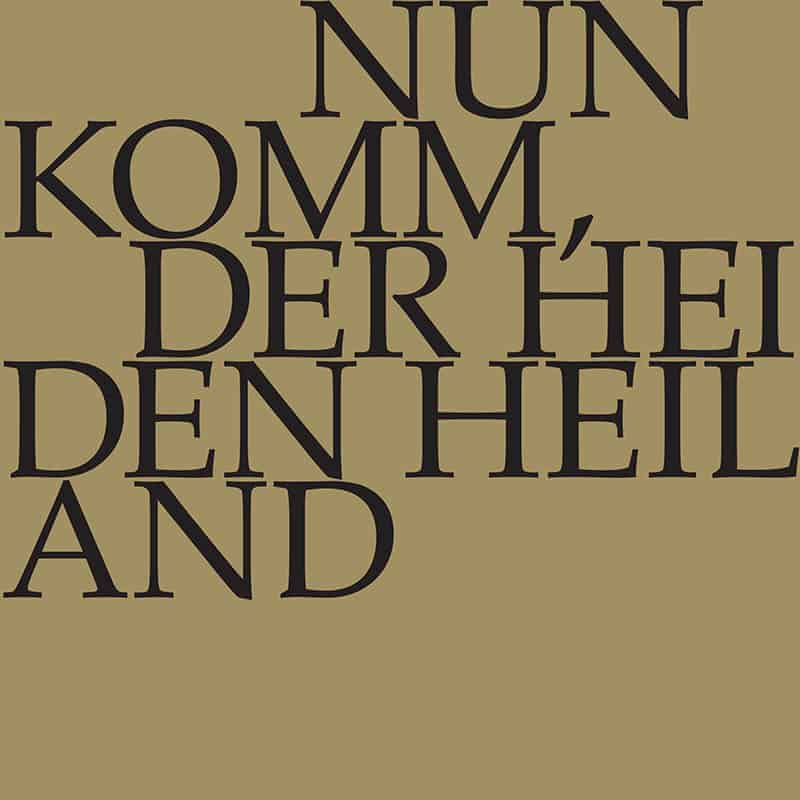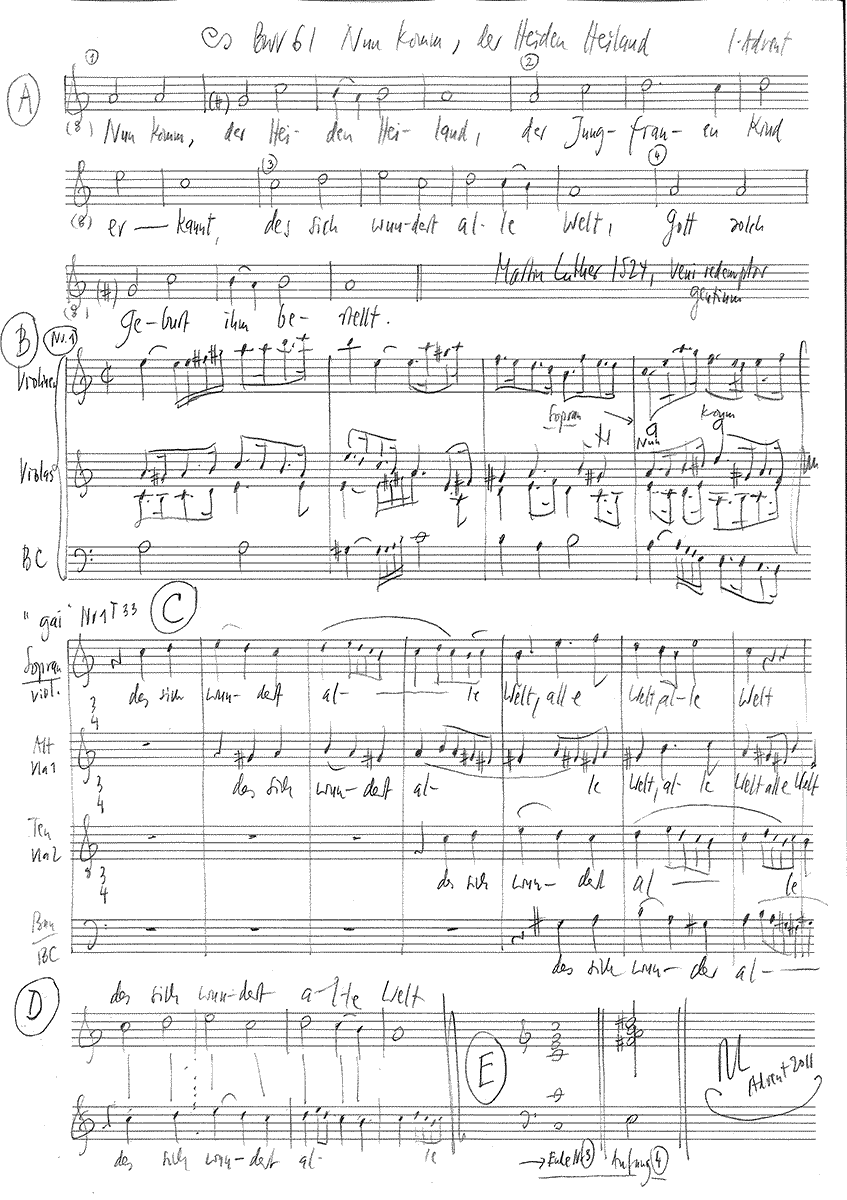Nun komm, der Heiden Heiland
BWV 061 // For the First Sunday in Advent
(Now come, the gentiles’ Savior) for soprano, tenor and bass, vocal ensemble, bassoon, strings and continuo
With its charm and youthful freshness, Cantata BWV 61 (“Now come, the gentiles’ Saviour”), numbers among Bach’s best-known sacred compositions. The work was written for the “Schlosskirche” in Weimar on the occasion of the First Sunday in Advent in 1714, and its vibrant melodies and daring ideas exude the experimental spirit of this inspiring genre.

Would you like to enjoy our videos ad-free? Subscribe to YouTube Premium now...
Workshop
Reflective lecture
Bonus material
Choir
Soprano
Susanne Frei, Guro Hjemli, Jennifer Rudin, Noëmi Sohn Nad
Alto
Antonia Frey, Alexandra Rawohl, Francisca Näf, Simon Savoy
Tenor
Clemens Flämig, Nicolas Savoy, Walter Siegel
Bass
Valentin Parli, Manuel Walser, William Wood
Orchestra
Conductor
Rudolf Lutz
Violin
Renate Steinmann, Monika Baer, Martin Korrodi
Viola
Susanna Hefti, Martina Bischof
Violoncello
Maya Amrein
Violone
Iris Finkbeiner
Bassoon
Susann Landert
Organ
Norbert Zeilberger
Musical director & conductor
Rudolf Lutz
Workshop
Participants
Karl Graf, Rudolf Lutz
Reflective lecture
Speaker
Noldi Alder
Recording & editing
Recording date
12/09/2011
Recording location
Trogen
Sound engineer
Stefan Ritzenthaler
Director
Meinrad Keel
Production manager
Johannes Widmer
Production
GALLUS MEDIA AG, Switzerland
Producer
J.S. Bach Foundation of St. Gallen, Switzerland
Librettist
Text No. 1
Martin Luther, 1524
Text No. 2, 3, 5
Erdmann Neumeister, 1714
Text No. 4
Quote from Revelation 3:20
Text No. 6
Philipp Nicolai, 1599
First performance
First Sunday in Advent,
2 December 1714
In-depth analysis
The introductory chorus presents Bach’s first attempt at melding the form of an instrumental overture with a chorale chorus. This combination not only lent a touch of courtly elegance to the new church year and the entrance of the heavenly king, but also linked his new duties as Concertmaster with his responsibility to compose monthly cantatas for the “Weg zur Himmelsburg” chapel, which was destroyed by fire in 1774. The French influence on the setting comes clearly to the fore in the fugal middle section (assigned to the third line of the chorale), as is clear to see in the marking of “gai” and the old-fashioned scoring of two viola parts and unisono violins. The resulting solemn yet celebratory aura also lends the chorale – reminiscent of a Gregorian chant – precisely the archaic tone that Bach favoured in his organ arrangements of the same early-reformation hymn. The ambitious combination of overture and chorale certainly reflected the revolutionary spirit of Neumeister, the cantata’s librettist, but at the same time, the style also confirmed all the prejudices levelled at modern “sacred cantatas”. Nevertheless, by emphasising secularisation, Bach proved in his stirring overturechorus that new approaches and devout music were not mutually exclusive endeavours.
The tenor recitative gives a brief outline of the Advent story before melding into an arioso setting that appears to observe the “approaching light” of the Saviour through the beatific eyes of a child. The tenor aria then turns to address the fact that Advent signifies the start of a new church year. With the words “Advance thy name in rank and honour, Uphold thou every wholesome doctrine, The pulpit and the altar bless!”, Neumeister, an experienced court preacher and superintendent, seeks God’s blessing for the upcoming period of office. That this requires unity in faith and the will to heed the example of Christ is illustrated by the unison scoring of the strings and the use of 9⁄ 8 time, a metre reminiscent of the Trinity.
After this sedate pastor’s idyll, the recitative “See now, I stand before the door” has the effect of a healing shock: God’s kingdom is neither distant nor abstract. Accompanied by the unusual musical gesture of pizzicato chords, Jesus Christ himself knocks at the door and, in all his penury and glory, requests entry. With this bold shift in tone, Bach transforms Neumeister’s deliberate use of Jesus’ words to an unsettling compositional climax: a sermon from on high in well-turned phrases is one thing, but when Christ himself arrives and speaks, the effect is quite another – and more direct and fundamental than all theology put together. In good Lutheran style, Jesus’ appearance here is not interpreted spiritually, but expressed by reference to the sacrament of communion, thus revealing in the briefest of spaces the actual presence of the living Christ.
After such a compelling Advent message, no further ado is required, but simply the childlike belief of the faithful soul, in keeping with the mystic roots of Lutheran doctrine. This is expressed in a da-capo aria “Open wide, my heart and spirit”, scored for soprano and continuo. Despite its apparent simplicity, the inspired setting reveals in its industrious continuo line a wealth of emotion and joyous anticipation that is essentially peerless even within Bach’s own extensive oeuvre. Indeed, the picture of contentment and beatitude that emerges in just 52 bars is one of extraordinary artistry and grace.
Libretto
1. Ouverture
Nun komm, der Heiden Heiland,
der Jungfrauen Kind erkannt,
des sich wundert alle Welt,
Gott solch Geburt ihm bestellt.
2. Rezitativ (Tenor)
Der Heiland ist gekommen,
hat unser armes Fleisch und Blut
an sich genommen
und nimmet uns zu Blutsverwandten an.
O allerhöchstes Gut,
was hast du nicht an uns getan?
Was tust du nicht
noch täglich an den Deinen?
Du kömmst und läßt dein Licht
mit vollem Segen scheinen.
3. Arie (Tenor)
Komm, Jesu, komm zu deiner Kirche
und gib ein selig neues Jahr!
Befördre deines Namens Ehre,
erhalte die gesunde Lehre
und segne Kanzel und Altar!
4. Rezitativ (Bass)
Siehe, ich stehe vor der Tür
und klopfe an. So jemand meine
Stimme hören wird und die Tür auftun,
zu dem werde ich eingehen
und das Abendmahl mit ihm halten,
und er mit mir.
5. Arie (Sopran)
Öffne dich, mein ganzes Herze,
Jesus kömmt und ziehet ein.
Bin ich gleich nur Staub und Erde,
will er mich doch nicht verschmähn,
seine Lust an mir zu sehn,
daß ich seine Wohnung werde.
O wie selig werd’ ich sein!
6. Choral
Amen, amen!
Komm, du schöne Freudenkrone,
bleib nicht lange!
Deiner wart’ ich mit Verlangen.
Noldi Alder
“Bach’s cantata repeatedly touches on folk music”.
A musical reflection: reflections of the cantata “Nun komm, der Heiden Heiland” in Appenzell folk music. An attempt.
The people of Appenzell sing chorales during Advent, as is the custom in other regions. in the songbook of Appenzeller Marie Josepha Barbara Brogerin from 1730, the song “Gott ist kommen auf die Erden” features two chorales from Johann Sebastian Bach’s cantata BWV 61 “Nun komm, der Heiden Heiland”. For about 30 years it can be noted that folk music has also been played in Appenzell, for example in support of, but also as a change from, the sermon. I am not aware of any church Advent music in the truest sense of the word that comes from Appenzell. And so it was not my intention to write Advent music for this occasion.
In this reflection, however, I would like to show in a musical way what is possible in a time preparing for Christmas – I deliberately do not want to speak of Advent – without having to sit in judgement on me later. What I have composed should be understandable for the people, in the sense that it is about easily comprehensible folk music themes. Bach’s cantata itself repeatedly touches on folk music, whether with parts of the two chorales or with consistent harmonic progressions. Bach clarified the Lord’s knocking in the bass recitative with pizzicato. I tried to make the snowing in of a landscape somehow audible with the music – we are talking about programme music. In doing so, I also formally adopted quotations from Bach’s music, such as harmonic progressions, consistent scales (bass leads) and, last but not least, the final bars. The folk music consists of the Alpine blessing motif and a jaunty Scottish melody. I want to be merry in the Advent season! The chord indications, by the way, serve the dulcimer player.
This text has been translated with DeepL (www.deepl.com).



